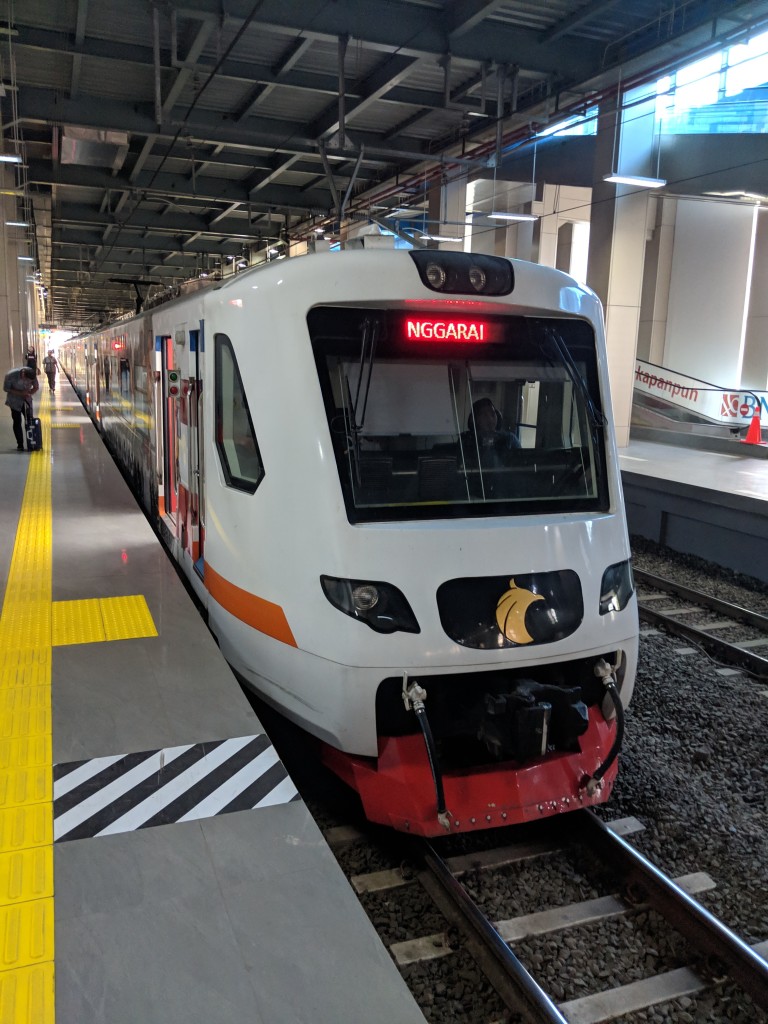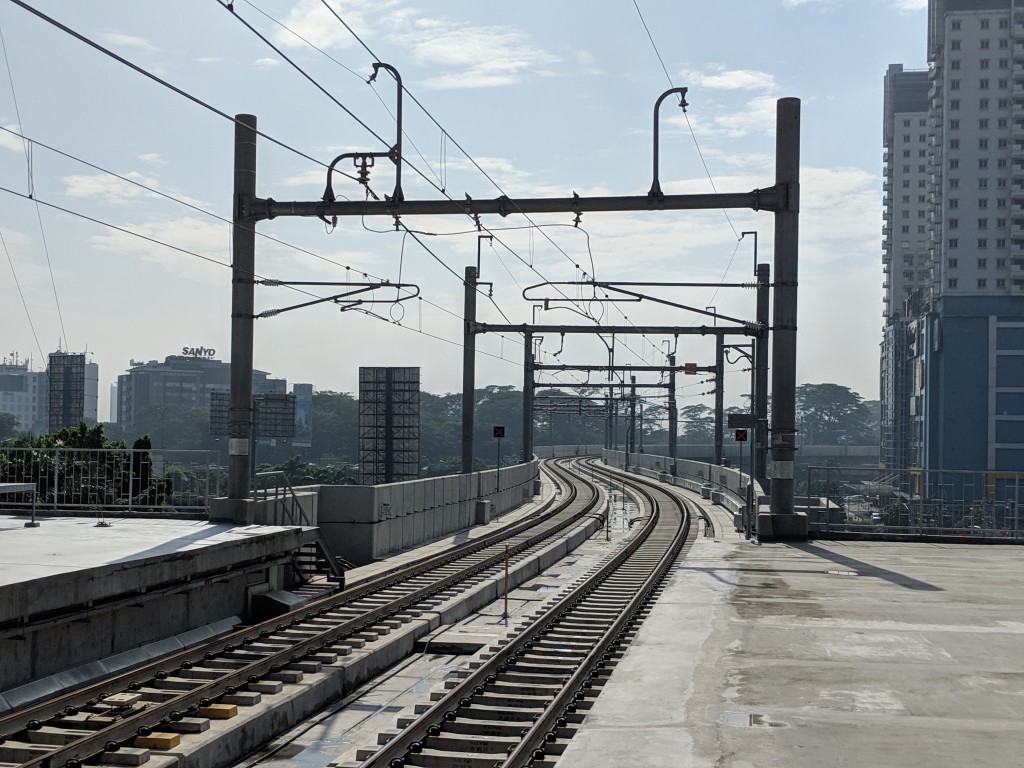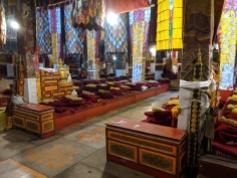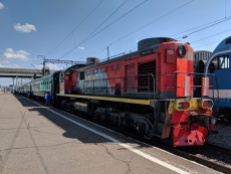While it may not register very high on the radar of most worldtrotters, Jakarta’s Soekarno-Hatta Airport (CGK) overtook Singapore’s Changi as the busiest hub in South-East Asia in 2017, growing 8% to serve over 63 million passengers. Serving the 264 million people scattered over Indonesia’s 17,000 islands, 75% of these pax were domestic, and the airport has been growing furiously to meet demand.
As part of this growth, late in 2017, Jakarta rolled out both a rail link from its main airport to the city and a shuttle connecting the airport’s three terminals. I recently had the chance to try out both, so here’s the scoop.
Soekarno–Hatta Airport Skytrain (Kalayang)
The airport terminal shuttle, dubbed the Skytrain in English and the Kereta Melayang (“Floating Train”) aka Kalayang in Indonesian, opened in September 2017. The system links together the three terminals plus a station for trains to the city, about which more later.
At Terminal 3, the newest of the lot and the one used by all Garuda flights, the Skytrain station is outside the terminal, connected by an elevated walkway to Departures and by an escalator to Arrivals. At T1 & T2, which date from the 1980s, the Skytrain stations are across the street and require crossing a road — not great.
The Skytrain itself, built by obscure Korean company Woojin Industrial, feels mildly buggy and wildly overengineered. The stations are bulky & enormous (much more so that the Jakarta MRT itself), and while capable of automatic operation, they’re manually driven by not one but two staff. The lady in the photo above, who’s responsible solely for the “Doors are closing” type announcements, is not hiding her face from my camera, but the sun! The ride is slow (max speed 30km/h) and somewhat bumpy. And all this just to provide trains every 10-15 minutes, back and forth between 4 stations, meaning it can easily take up to 30 minutes from T3 to the train station: 5 min walking, up to 15 min to wait, then 10 minutes on the shuttle.
Soekarno–Hatta Airport Railink (KA Bandara)
Opened 26 December 2017, the “Railink” (sic) offers a 46-minute ride from Soekarno-Hatta Airport (CGK) to BNI City (Sudirman Baru) in the city center, with two stops along the way at Batu Ceper and Duri. In Indonesian, it’s mostly signposted as KA Bandara, KA being Kereta Api (“fire cart” aka train) and Bandara being “airport”. Travel times between central Jakarta and the airport by car are notoriously variable, taking an hour on a good day but 2-3 or more on bad days, so this should be wildly popular. Was it?
In a nutshell, no, not really. In addition to the mandatory Skytrain rumba described above, the system appears to go out of its way to discourage non-Indonesian riders. Tickets can only be purchased from ticket machines, which summarily reject most but not all non-Indonesian credit cards. The information counter staff tried to help by using their own, only for the reader to fail repeatedly with not one but two local Indonesian cards. One of them tried again at the ticket machine with their card, managing to get it to spit out a 70,000 IDR ticket (US$5, around half the price of a taxi), but when I tried to repay them with 100,000 IDR cash they didn’t have any change. They now suggested breaking a bill at the convenience store next door, but we were now approaching departure time, so I gave them a rather generous 30,000 IDR tip and hotfooted onto the train.
Incidentally, there are two other ways to short-circuit this mess:
- You can buy tickets online at railink.co.id, which apparently does accept foreign credit cards. However, you need to either buy your ticket for a specific time slot (plane late? too bad) or pay extra for a “Flexi” ticket that can be used for any train, and the web shop is beyond terrible: for example, you need to enter an Indonesian phone number (no country codes allowed), and if you make any mistake in filling out the form it’s cleared out completely!
- There’s currently a payment card war raging into Indonesia (Brizzi, Flazz, Blink, etc), and you can use some but not all of these to pay for your tickets on the spot, including the Brizzi cards sold at the convenience store.
Payments sorted, I got on the train, which was rattlingly empty. with six carriages containing perhaps 20 or so passengers. This wasn’t the train’s fault, as the Bombardier EA203 trainset was rather modern and pleasant, with air-con, comfy seating, USB power in the seats and even luggage racks by the doors. It was just rather odd having an entire carriage to myself!
The train left precisely on time and started its trundle toward the city. The initial 12 km of track are new, while the remaining 24 km of the route is on existing track shared with regular commuter trains and hence offering ground-level views of the “real” Jakarta. Jakarta’s commuter rolling stock is almost entirely secondhand from Japan, like the refurbished Tokyo Metro 6000 series train pictured above at Duri station, which I used to ride on my Chiyoda Line commute in my student days. The condition of the track is generally not great, with the train click-clacking along loudly and reversing direction at Duri for the final stretch into current terminus Sudirman Baru (“New Sudirman”), currently branded as BNI City after a sponsoring bank.
This shiny new station is rather slick and well laid out, with platforms underneath a concourse level that has shops in the middle and waiting taxis at one end. There are also a few signs vaguely pointing in the direction of MRT Dukuh Atas and the old Sudirman commuter station, both a few hundred meters away, but there’s no “proper” tunnel or bridge between the three. (July 2019 update: A connecting tunnel between the three is now open!)
At present, almost all trains terminate at BNI City, with only around 3 trains a day continuing all the way to Bekasi in eastern Jakarta. However, the plan is to run all trains to Manggarai in south Jakarta, the busiest train station in the city, where additional platforms are under construction. Once complete around April 2019, this should provide easy interchange to three of Jakarta’s commuter lines and boost ridership nicely.
I took the train back as well, and it worked fine, running exactly on schedule to boot. All in all, the link is surprisingly respectable and I intend to make the most of it when I visit, but there are a number of design flaws that make it much less useful than it could be.
- The biggest issue is the clunky forced Skytrain transfer, which could have been avoided entirely if the train line had been extended by an extra kilometer or two to connect directly with Terminal 3. Yes, this would have required either elevating the line or putting some of it in a tunnel, which would have been expensive, but then the extra Skytrain station would not have been necessary either.
- Sharing track with existing lines is a sensible cost-cutting measure, but having minimal to no provisions for regular and express trains to pass each other is not. This forces the train to slow down to the same speed as regular all-stops commuters, so it averages only 50km/h. If that speed could pushed up to just 72 km/h, the journey to the airport would take only 30 minutes.
- The payment mess is just inexcusable and gives a terrible first impression. I presume the insistence on cashless is a combination of wanting to be modern and making sure all money is accounted for, but since they’re already paying for several people to staff the counter, might as well take cash, no?
Next time, I’ll try out the rail link to MRT transfer, and I’m looking forward to seeing how the Greater Jakarta (Jabodebek) LRT fits in if/when completed around 2021.
More train adventures in Jakarta: MRT opening week




















































































































































